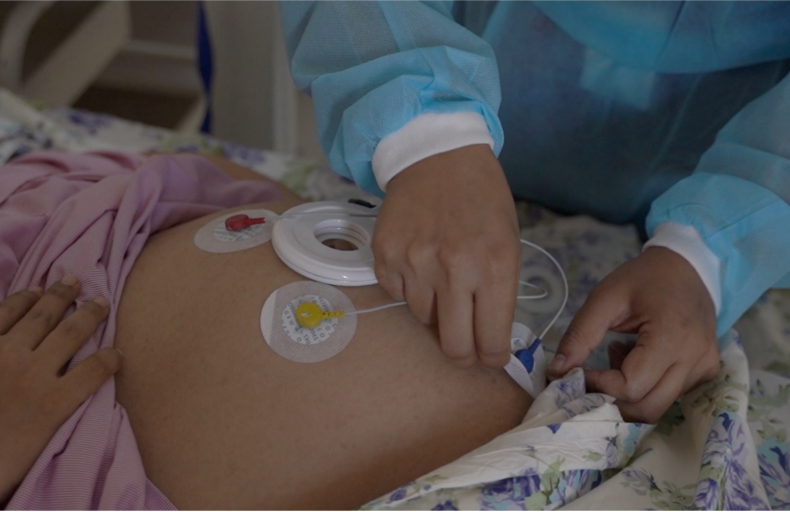
Newer upcoming technologies today, allow Fetal Heart Monitoring at home – so that expectant Mothers can continue normal activities, rather than lying down in a Labour ward, tied down to a monitor with lot of wires. This is a strong enough reason for getting NST machine on rent instead of monitoring in the hospital.
How is Fetal Heart monitoring at home made possible?
We are talking about Wireless, beltless water-proof electrode patch and pod device, that does not need any re-positioning along with movement of the baby (just a one-time placement). All you have to do is – get a one-time configuration and placement of the patch done during a regular visit to your Obstetrician and come home.
-
Wireless, beltless, patch & Pod based fetal heart monitoring device
– This enables normal mobility & freedom for the expectant Mother at comforts of her home. The Doppler based Tocography NST machines in use today, are wired devices connected to a monitor and hence do not allow mobility.
-
EMG signal vs Ultrasound Doppler technology
– In the older ultrasound doppler and transducer based (Cardiotocography) CTG machines, often repositioning of transducers is required when the baby moves around in the womb, since the signal gets weakened. This is an important reason why the monitoring has to be done in the hospital under caregivers. No such re-positioning of electrodes is required in the newer wireless devices that are EMG signal based. EMG signals are strong enough to track Fetal Heart Rate, Maternal Heart Rate and Uterine Contractions, no matter, how much fetal movement is there. EMG signals are also more effective than Ultrasound Doppler signal even in cases of Mothers with high Body Mass Index (BMI).
-
Remote monitoring by Doctor/ Caregiver
– Devices like Keyar from Janitri allow regular transmission and cloud storage of data. Hence this provides mapping trends over the labour and also mobile notifications/ alerts to the doctor, wherever they may be home/hospital/ OPD or Surgery – so that immediate action can be taken.
-
Fetal Heart Monitoring Device available on rent
– Best news is you can get this NST machine on rent and pay as per use.
Fetal Heart monitoring could sometime be done for days. This could be expensive, stressful and boring for the expectant parents. Fetal heart monitoring at home is both a comfortable and cost-effective option.
What is a Fetal Heart Monitor or NST machine?
Fetal Heart Monitor is also known as Cardiotocography or CTG machine, Non-Stress Test or NST machine. Most Fetal Heart Monitors available today use Ultrasound Doppler technology and measure & report Fetal Heart rate (FHR), Maternal Heart rate (MHR) and Uterine Contractions (UC). There are newer Fetal Heart Monitors coming up with better technology aimed at providing more accurate, timely data and alerts to caregivers while giving more comfort & mobility to the pregnant mother during labour.
Why should Fetal Heart rate be monitored during Labour?
The main purpose of fetal heart rate monitoring during pregnancy especially during labour is to detect fetal distress. Fetal distress usually indicates that the baby is not getting enough oxygen. Without enough oxygen the stress of labour could threaten an infant’s health or even survival. Babies who experience fetal distress, such as having unusual heart rate or passing meconium during labour, are at greater risk of complications after birth. Lack of oxygen during birth can lead to very serious complications for the baby, including a brain injury, cerebral palsy and even stillbirth.
Hence it is crucial to detect fetal distress at the earliest and ensure early delivery for the infant’s welfare – operative vaginal delivery (using forceps or a vacuum device) or a cesarean section.
How is fetal distress diagnosed through Fetal Heart Monitor?
Fetal distress is diagnosed by reading the baby’s heart rate. A baby’s heart rate during labour is expected to be between 110 – 160 beats per minute, but it may fluctuate above or below this rate for several reasons. Short bursts of acceleration or decelerations in the baby’s heart rate can also be normal.
Abnormal heart rate may be due to reasons such as the umbilical cord being compressed and hence slow-down in blood flows to the baby. Sometimes a simple intervention such as changing the mother’s position could release the pressure on the umbilical cord and improve the situation.
Fetal heart rate monitors are useful medical devices saving several infant’s lives. However, fetal heart rate monitoring is not all. Other factors like the mother’s health status at the time of labour are also very important.
Advanced NST machines include other maternal health parameters such as NiBP, SpO2, Temperature, Respiration and ECG (almost replacing a 5-para monitor) as well as FHR, MHR and UC. In case of normal CTG machines the doctor needs to process all the data in their head and decide on further course of action.
This is where some of the upcoming devices are making advances based on AI, analytics – essentially processing all relevant data comprehensively in place of a good doctor and raising timely alerts.
Fetal Heart monitoring could sometime be done for days. This could be expensive and boring for the patient. Hence Fetal heart monitoring at home is both a convenient and cost-effective option.
Contact us on +917019759765 or +918971223957 or [email protected] for Fetal Heart monitoring at home or to take NST machine on rent.
PrimedeQ is an e-Marketplace for buying, selling, renting, servicing and spares of medical equipment. We offer all types of used / refurbished medical equipment , including maternity equipment, Lab equipment, X-Ray, TMT, ECG, anesthesia machine, ultrasound machines, endoscope and ultrasound probe repair services etc.
https://in.linkedin.com/in/shanthi-mathur-ab07838
